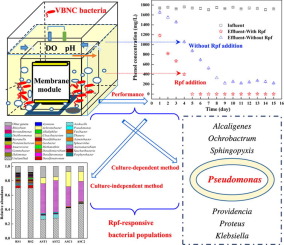Chemical Engineering Journal ( IF 13.3 ) Pub Date : 2018-09-25 , DOI: 10.1016/j.cej.2018.09.197 Xiaomei Su , Yuyang Wang , Binbing Xue , Muhammad Zaffar Hashmi , Hongjun Lin , Jianrong Chen , Zhen Wang , Rongwu Mei , Faqian Sun

|
Enhancement of bacterial activity in membrane bioreactor (MBR) is crucial to overcome the low efficiency of biological process for treating phenolic wastewater with high salinity. It is predicted that resuscitation promoting factor (Rpf) from Micrococcus luteus may improve the degradative performance of bacterial populations. In this study, a control MBR (c-MBR) and a treatment MBR (t-MBR) with Rpf addition were operated for assessing the influences of Rpf. The potential bacterial populations in response to Rpf addition were investigated by both culture-dependent and culture-independent techniques. Results showed that Rpf significantly enhanced phenol removal under high salinity stress. In the MBR system, a higher efficiency for phenol removal in the effluent was observed in t-MBR compared to that in c-MBR (nearly zero versus 221–272 mg/L) under phenol concentration of 1800 mg/L and 30 g/L NaCl in the influent. Batch tests further demonstrated that, at the initial phenol concentration of 1500 mg/L and 60 g/L NaCl, sludge from t-MBR could achieve almost 100% phenol removal within 100 h, while it was only 54.7% for the sludge from c-MBR. High-throughput 16S rRNA analysis indicated that the genus Rhizobium in Alphaproteobacteria was greatly enriched in the t-MBR. The genus Pseudomonas in Gammaproteobacteria was identified as the dominant resuscitated bacteria. These findings suggested that Rpf-responsive bacterial species belonging to Alphaproteobacteria and Gammaproteobacteria were key populations contributed to better phenol-degrading capabilities under high salinity condition.
中文翻译:

复苏促进因子(Rpf)在膜生物反应器处理高盐酚废水中的影响:性能鲁棒性和Rpf响应细菌种群
膜生物反应器(MBR)中细菌活性的增强对于克服生物方法处理高盐度含酚废水的低效率至关重要。据预测,来自微球菌的复苏促进因子(Rpf)可能会改善细菌种群的降解性能。在这项研究中,对照MBR(c-MBR)和加有Rpf的治疗MBR(t-MBR)用于评估Rpf的影响。通过依赖于培养物和不依赖于培养物的技术研究了响应RPF添加的潜在细菌群体。结果表明,在高盐度胁迫下,RPF显着提高了苯酚的去除率。在MBR系统中,在苯酚浓度为1800 mg / L和30 g / L氯化钠进水。批量测试进一步表明,在初始苯酚浓度为1500 mg / L和60 g / L NaCl的情况下,t-MBR产生的污泥可在100 h内实现几乎100%的苯酚去除,而来自c-MBR的污泥仅为54.7%。高通量16S rRNA分析表明该属α-变形杆菌中的根瘤菌在t-MBR中大量富集。属假单胞菌在γ-变形菌被确定为主导的复苏细菌。这些发现表明,在高盐度条件下,属于丙型细菌和丙型细菌的对Rpf敏感的细菌是有助于提高苯酚降解能力的关键种群。


















































 京公网安备 11010802027423号
京公网安备 11010802027423号